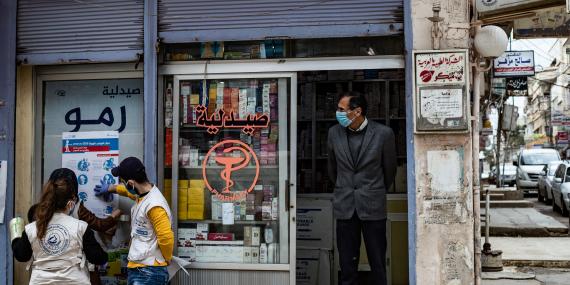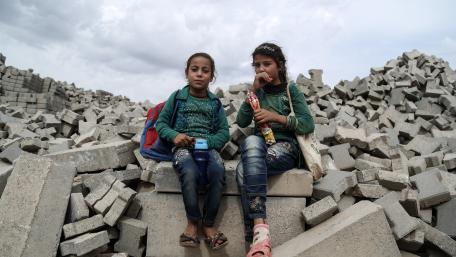Qamishly, Syria
Two volunteers hang posters providing information on COVID-19 protection measures in Qamishly, a city in northeast Syria. The posters, placed at pharmacies, supermarkets and clinics, contain messages on best handwashing practices, seeking medical assistance if showing symptoms and how to care for someone who exhibits symptoms. UNICEF/Delil Souleiman
COVID-19 has triggered the deepest global recession since the Great Depression in the 1930s. IMF is projecting that global GDP will contract by 4.4 per cent in 2020. Advanced economies are forecast to contract by 5.8 per cent in 2020, emerging market and developing economies are projected to contract by 3.3 per cent, and growth among low-income countries is expected to contract by 1.2 per cent.
The last year has seen the broadest collapse in per capita incomes since 1870. The World Bank expects that by the end of 2021, real GDP per capita in sub-Saharan Africa will likely regress to the same level as 2007. A recovery in 2021 is expected to be modest and uneven, mostly recovering lost output.
Extreme poverty is on the rise for the first time since 1998. Between 88 million and 115 million people could fall back into extreme poverty due to COVID-19, with an additional increase of between 23 million and 35 million people in 2021, potentially bringing the total number of new people living in extreme poverty to between 110 million and 150 million. The largest increases are projected in Southern Asia and sub-Saharan Africa. Without swift policy action, the global poverty rate could be as high as 7 per cent in 2030, relative to the pre-pandemic projection of 3 per cent.
Contraction of Gross Domestic Product (2019–2025)
Unemployment is increasing drastically. Compared to pre-pandemic levels, the total work-hour losses in the second quarter of 2020 were 17.3 per cent, equivalent to 495 million full-time jobs worldwide. Projections for the final quarter of 2020 continue to be bleak, with baseline work-hour losses amounting to 8.6 per cent, equivalent to 245 million full-time jobs worldwide. Should a second wave of COVID-19 infections result in widespread workplace closures, the work-hour losses for the final quarter of 2020 could increase to 18 per cent, equivalent to 515 million full-time jobs. These contractions will particularly hurt the informal sector, creating high levels of household vulnerability. Nearly 80 per cent of the estimated 2 billion workers in the informal economy have been significantly affected by these reductions in work-hours, creating high levels of household vulnerability. Many are working in the hardest-hit sectors such as accommodation and food services, manufacturing and retail. Women - who make up the majority of informal workers and are over-represented globally in these sectors - have been disproportionately hurt by economic losses.
Work-hours lost due to COVID-19
Even before the pandemic there were worrying economic trends, with signs of a looming debt crisis in developing countries. Prior to the COVID-19 outbreak, 44 per cent of low-income and least developed countries were either at high risk of or already in debt distress. Eleven of the 25 countries with a humanitarian response plan (HRP) in 2020 are at high risk of or in debt distress. Global remittances, a lifeline for many, contracted sharply in the first half of the year but they were showing signs of recovery at the time of writing. Low-income, primary-commodity-exporting countries were particularly affected by the drop in oil prices this year. Developing economies in general, including small island states, were also deeply affected by the near collapse in global travel and tourism.
Rapid availability and deployment of international funds to support developing countries will be crucial to creating fiscal space. The UN Secretary-General has called for a debt standstill and, ultimately, debt restructuring for developing countries. International Financial Institutions (IFIs) and the G20 are providing debt service relief and have responded to emergency financing requests, but significant gaps remain. To date, major IFIs have committed US$85.1 billion to low- and middle-income countries for COVID-19 response, excluding two large-scale flexible credit lines to Peru and Colombia. The majority of these funds are loans (93 per cent), further adding to debt pressure. Approximately 9 per cent ($10.1 billion) of COVID-19 response financing has been committed to low-income countries.
Economic contraction
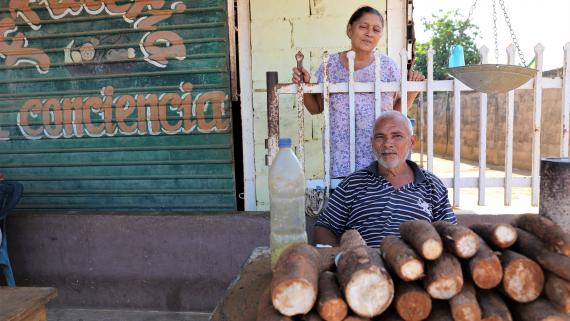
Extreme poverty is on the rise for the first time since 1998. Due to COVID-19, up to 150 million new people could be living in extreme poverty by 2021.
Photo: OCHA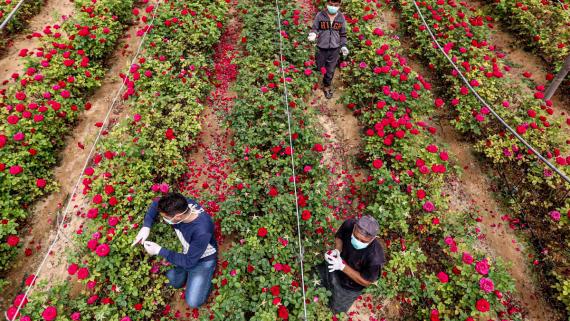
Eleven of the twenty-five countries with a Humanitarian Response Plan in 2020 are at high risk of or in debt distress.
Photo: UNDP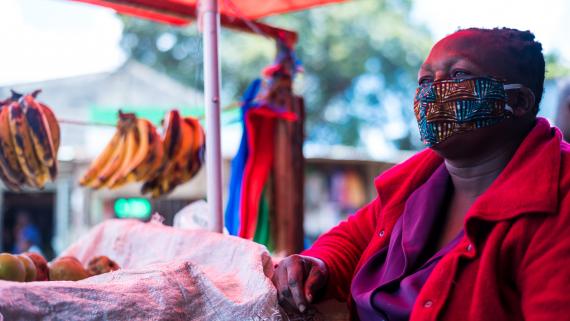
Nearly 80 per cent of the 2 billion workers in the informal economy have been hurt by work-hour losses. Women are disproportionately affected.
Photo: UNODA has become increasingly important, given the 49 per cent decline in foreign direct investment. ODA growth slightly increased in 2019 (1.4 per cent) to $152 billion, but a longer-term economic recession could see a sharp drop in global ODA levels. The overall level of ODA could decline in 2020 by $11 billion to $14 billion depending on the recession’s effect on OECD DAC members. Contingent on the speed of global economic recovery, a fall of $25 billion by 2021 is possible.
Protecting the 10 per cent of the world’s most vulnerable people from the worst impacts of the pandemic would cost $90 billion. This is the equivalent of less than 1 per cent of the COVID-19-related global stimulus package ($12 trillion) implemented by OECD and G20 countries. Without the right combination of sufficient relief and recovery assistance, the cost of inaction to public health, nutrition, poverty, social welfare, food security, education, economy, protection, stability and conflict will grow exponentially. This assistance must be guided by human rights and the UN framework for the immediate socioeconomic response to COVID-19.
Further reading
Source: IMF
Source: World Bank
Source: OCHA
References
- 2019 is the most recent year for which complete data was available at the time of publication. Where part-year data was available from 2020, this is noted.
- IMF World Economic Outlook Update October 2020; IMF, World Economic Outlook Update, June 2020; IMF World Economic Outlook July 2009;
- World Bank, Poverty and Shared Prosperity, October 2020
- The Sustainable Development Goals Report 2020, July 2020
- ILO ILO Monitor: COVID-19 and the World of Work, sixth edition 23 September 2020; ILO Monitor: COVID-19 and the World of Work, third edition 29 April 2020; and ILO Monitor: COVID-19 and the World of Work, second edition 7 April 2020.
- UNDP United Nations Statement to the Development Committee (Joint Ministerial Committee of the Boards of Governors of the World Bank and the International Monetary Fund) 17 April 2020
- IMF - as of 30 September 2020 - https://www.imf.org/external/Pubs/ft/dsa/DSAlist.pdf
- IMF World Economic Outlook Update October 2020; World Bank, World Bank Predicts Sharpest Decline of Remittances in Recent History, 22 April 2020; Bustamante, L. Amid COVID-19, remittances to some Latin American nations fell sharply in April, then rebounded. Pew Research Center, 31 August 2020
- United Nations, Secretary-General's Policy Brief: The Impact of COVID-19 on Food Security and Nutrition, June 2020, p.3
- WFP, Economic and food security implications of the COVID-19 outbreak, 6 July 2020, p. 15
- These figures include COVID-19-specific grant and lending that has been committed to low- and middle-income countries by the IMF, World Bank, Asia Development Bank (ADB), African Development Bank (AfDB), Inter-American Development Bank (IDB), and Islamic Development Bank (IsDB). The sample covers 123 countries.
- Centre for Disaster Protection COVID-19: Tracking multilateral ODA flows to meet crisis needs (2 September 2020) and Funding COVID-19 response (21 September 2020)
- UNCTAD Global foreign direct investment falls 49%, outlook remains negative 27 October 2020; UN World Tourism Organization International Tourism and COVID-19
- OECD The impact of the coronavirus (COVID-19) crisis on development finance 24 June 2020
- Development Initiatives Coronavirus And Aid Data: What The Latest DAC Data Tells Us.
- OCHA, Global Humanitarian Response Plan, July Update 2020 and IMF Fiscal Policy for an Unprecedented Crisis 14 October 2020
- OCHA, Global Humanitarian Response Plan, July Update 2020; OCHA, The cost of doing nothing: The price of inaction in response to the COVID-19 crisis, 10 July 2020

